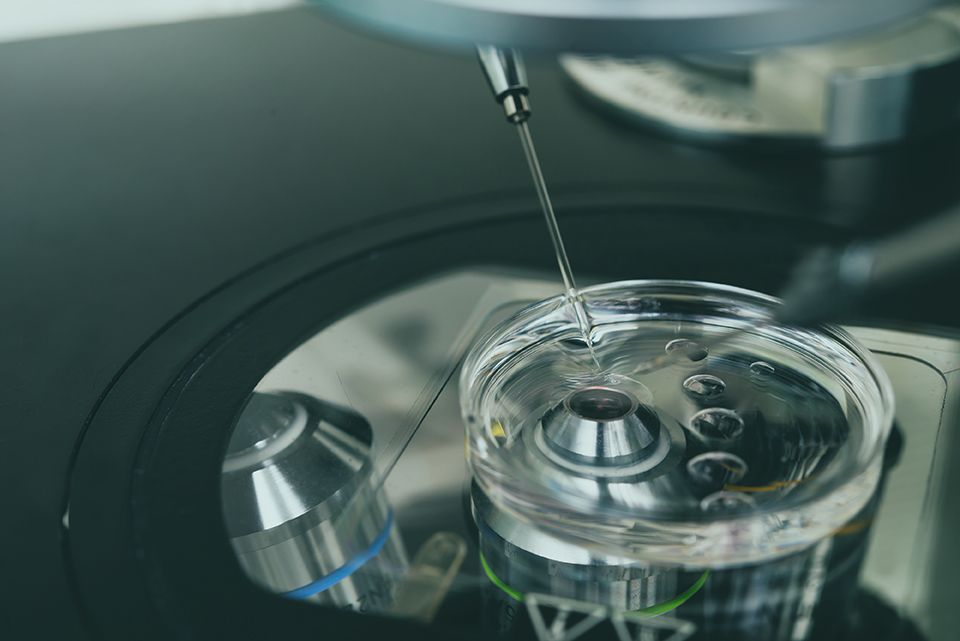Our donor candidates undergo a strict protocol for their selection through different stages, which is under continuous revision and improvement. We introduce new screening tests and improve existing ones in order to offer the highest success rates for fullfulling a woman´s dream, not only of achieving motherhood but also having a healthy baby.
We do not only perform the tests required by Spanish law but complete the study according to recommendations of International Scientific Societies
- 95 % of our donors are university students
- 99% of donors are Spanish nationals.
- Aged between 18 – 35 years old
- Average age: 25 years old
 Oocytes Donors Selection
Oocytes Donors Selection
An Individual and family medical history is carried out tracing back to grandparents, to rule out hereditary diseases, according to Spanish Law 9/2014 and RD 412/1996.
We add an evaluation the psychological history of the donor and his family environment as recommended by Spanish Society for Fertility (SEF).
Since the law does not address the exclusion criteria, we proceeded back in 2007 , with the help of various experts in each subject and in the context of Ceifer Classroom Training, to the publication of the book «THOUGHTS ON THE EVALUATION OF GAMETE AND EMBRYO DONORS«. This study provides support for the selection of donors.
- A general physical examination is performed.
- Cytology:
- Tests for Chlamydia
- Microbiological culture: enterobacteria, gardenerella, neissseria gonorrehoeae, urogenital mycoplasmas and fungi.
STD serology is initially performed at the donor selection stage, and is renewed quarterly when oocyte donations are made.
| STDs | Markers |
| HIV | Ag p24, Ab 1+2 |
| Hepatitis B | HBsAg, HBsAb, HBcAb (IgM, IgG) |
| Hepatitis C | Ab VHC IgM, IgG |
| Syphilis | TPHA, VDRL |
| Herpes simplex type 1 | Ab VHS I IgM |
| Herpes simplex type 2 | Ab VHS II IgM |
| Cytomegalovirus (CMV) | Ab CMV (IgG, IgM) |
• PCR Analysis: HIV 1, HIV 2, Hepatitis B and Hepatitis C the day when follicule extraction takes place.
• Serum bank: we keep serum samples from the day when oocytes where extracted, to allow for a retrospective study measuring the levels of various biochemical markers at the moment of the oocytes extraction.
- Blood type
- Rh Factor
- Blood count
- Hemostasis:
- Actividad Protrombina
- TTPA
- Biochemistry:
- Glucose
- Creatinine
- Total cholesterol
- HDL cholesterol
- Triglycerides
- Transaminases (GOT, GPT)
We have implemented a protocol for the study of genetic diseases at our sperm bank which is unique worldwide.
CEIFER Protocol for genetic studies allows discarding potential donors who are carriers of the most prevalent genetic diseases, specifically those of autosomal recessive nature that manifest only in the offspring.
Chromosome Study – Kariotype
Only donor candidates with normal kariotype are accepted. Additionally candidates with polymorphic karyotypes are discarded since they offer lower results for assisted reproduction techniques.
Carriers of autosomal recessive monogenic diseases
Genetic studies are carried out to eliminate donor candidates who are carriers of the most prevalent autosomal recessive monogenic diseases in our environment (Mediterranean area of Europe):
| Disease | Gene |
|---|---|
| Spinal Muscular Atrophy | SMN1 |
| Cystic Fibrosis | CFTR View Table 1* |
| X-chromosome linked diseases (57) | Duchenne, Hemophilia A - B, Fabry, Pompe, G6PD, AR, mental retardation...* View Table 2* |
To reduce the risk of offspring affected by these and other diseases, it is recommended to perform Genetic Matching (more information below in DNA Bank and Genetic Matching)
DNA BANK
From 2005 on CEIFER Biobanco has a sperm donor DNA bank. In this way, in case of genetic disease arising in the offspring, we can carry out the pertinent genetic studies.
CEIFER Biobanco thus has a global vision and the most advanced technology for:
- Screening for genetic disorders in live birth cases where offspring is affected.
- Implement screening tests for new genetic disorders in our screening protocols.
GENETIC MATCHING
Genetic matching allows the genetic information from the donor woman to be compared with that of the male partner of the recipient woman in order to avoid the transmission of autosomal recessive genetic diseases.
To this end, a mass sequencing test against more than 307 genes related to monogenic recessive diseases is carried out. This analysis is performed using the most modern techniques of mass sequencing (Next Generation Sequencing – NGS).
Among these 307 genes screened there are variants with a particularly high incidence in the Mediterranean area. The results from our donor samples are compared with the similar genetic study performed on the recipient woman, selecting a suitable donor so that sperm donor and the receiving woman do not share mutations in the same genes.
(The genetic matching protocol does not eliminate the risk in the offspring of being affected or being a carrier of recessive diseases, even if it is one of the diseases studied. Its objective is the significant reduction of risks, depending on the disease object of study).
SCREENED GENES
| Enfermedad | Gen |
|---|---|
| 17-beta-hydroxysteroid dehydrogenase X deficiency | HSD17B10 |
| 2-methylbutyrylglycinuria | ACADSB |
| 3-Methylcrotonyl-CoA carboxylase 1 deficiency | MCCC1 |
| 3-Methylcrotonyl-CoA carboxylase 2 deficiency | MCCC2 |
| Aarskog-Scott syndrome, Mental retardation, X-linked syndromic 16 | FGD1 |
| Achondrogenesis Ib | SLC26A2 |
| Achromatopsia-3 | CNGB3 |
| Acyl-CoA dehydrogenase, medium chain, deficiency of | ACADM |
| Acyl-CoA dehydrogenase, short-chain, deficiency of | ACADS |
| Acyl-CoA dehydrogenase, short-chain, deficiency of | CYP17A1 |
| Adrenal hyperplasia, congenital, due to 21-hydroxylase deficiency | CYP21A2 |
| Adrenoleukodystrophy | ABCD1 |
| Alkaptonuria | HGD |
| Allan-Herndon-Dudley syndrome | SLC16A2 |
| Alpha-methylacetoacetic aciduria | ACAT1 |
| Alpha-thalassemia/mental retardation syndrome | ATRX |
| Alport syndrome, autosomal recessive, | COL4A4 related |
| Anauxetic dysplasia | RMRP |
| Androgen insensitivity | AR |
| Argininemia | ARG1 |
| Argininosuccinic aciduria | ASL |
| Arts Syndrome | PRPS1 |
| Aspartylglucosaminuria | AGA |
| Ataxia with isolated vitamin E deficiency | TTPA |
| Ataxia-telangiectasia | ATM |
| Auditory neuropathy, autosomal recessive, 1 | OTOF |
| Autoimmune polyendocrinopathy syndrome, type I, with or without reversible metaphyseal dysplasia | AIRE |
| Autosomal Recessive Polycystic Kidney Disease (ARPKD) | PKHD1 |
| Bardet-Biedl syndrome 1 | BBS1 |
| Bardet-Biedl syndrome 10 | BBS10 |
| Bardet-Biedl syndrome 14, Joubert syndrome 5, Meckel syndrome 4, Senior-Loken syndrome 6 | CEP290 |
| Bardet-Biedl syndrome 2 | BBS2 |
| Bartter syndrome, type 4a | BSND |
| Biotinidase deficiency | BTD |
| Bjornstad syndrome | BCS1L |
| Canavan disease | ASPA |
| Carbamoylphosphate synthetase I deficiency | CPS1 |
| Carnitine deficiency, systemic primary | SLC22A5 |
| Carnitine-acylcarnitine translocase deficiency | SLC25A20 |
| Cerebral creatine deficiency syndrome 1 | SLC6A8 |
| Cerebrotendinous xanthomatosis | CYP27A1 |
| Ceroid lipofuscinosis, neuronal, 5 | CLN5 |
| Ceroid lipofuscinosis, neuronal, 8 | CLN8 |
| Ceroid lipofuscinosis, neuronal, 10 | CTSD |
| Ceroid lipofuscinosis, neuronal, 3 | CLN3 |
| Ceroid lipofuscinosis, neuronal, 6, 601780 | CLN6 |
| Ceroid lipofuscinosis, neuronal, 7 | MFSD8 |
| Ceroid lipofuscinosis, neuronal, type 1 | PPT1 |
| Ceroid lipofuscinosis, neuronal, type 2 | TPP1 |
| Charcot-Marie-Tooth disease, type 4B1 | MTMR2 |
| Charcot-Marie-Tooth disease, type 4C | SH3TC2 |
| Charcot-Marie-Tooth disease, type 4D | NDRG1 |
| Charcot-Marie-Tooth Neuropathy Type 4A | GDAP1 |
| Cholestasis, benign recurrent intrahepatic, 2 | ABCB11 |
| Citrullinemia | ASS1 |
| Citrullinemia, neonatal-onset type II | SLC25A13 |
| Coffin-Lowry syndrome | RPS6KA3 |
| Combined malonic and methylmalonic acidemia | ACSF3 |
| Cone rod dystrophy 3 | ABCA4 |
| Cone-rod dystrophy, X-linked, 1 | RPGR |
| Congenital disorder of glycosylation, type Ia | PMM2 |
| Corneal endothelial dystrophy and sensorineural deafness (CDPD) | SLC4A11 |
| CPT I (Carnitine Palmitoyltransferase IA) deficiency, hepatic, type IA | CPT1A |
| CPT II (Carnitine Palmitoyltransferase) deficiency, lethal neonatal | CPT2 |
| CRASH/ MASA syndrome | L1CAM |
| Cystathioninuria | CTH |
| Cystic fibrosis, Congenital bilateral absence of vas deferens | CFTR |
| Cystinosis, atypical nephropathic | CTNS |
| Cystinuria | SLC3A1 |
| Cystinuria | SLC7A9 |
| Deafness, autosomal recessive 1A (DFNB1-related) | GJB2 |
| Deafness, autosomal recessive 12 | CDH23 |
| Deafness, autosomal recessive 18A | USH1C |
| Deafness, autosomal recessive 23 | PCDH15 |
| Deafness, autosomal recessive 4, with enlarged vestibular aqueduct | SLC26A4 |
| Deafness, digenic GJB2/GJB3 | GJB3 |
| Dent disease 2 | OCRL |
| Dihydrolipoamide dehydrogenase deficiency | DLD |
| Duchenne muscular dystrophy, Becker muscular dystrophy | DMD |
| Dysprothrombinemia, Prothrombin thrombophilia / Factor II deficiency | F2 |
| Ehlers-Danlos syndrome, type VI | PLOD1 |
| Ellis-van Creveld Syndrome | EVC2 |
| Emphysema due to Alpha1 Anti-Trypsin deficiency | SERPINA1 |
| Epidermolysis bullosa dystrophica, AR | COL7A1 |
| Epidermolysis bullosa, junctional, Herlitz type | LAMB3 |
| Epilepsy, X-linked, with variable learning disabilities and behavior disorders | SYN1 |
| Epileptic encephalopathy, early infantile, 1 | ARX |
| Ethylmalonic encephalopathy | ETHE1 |
| Fabry disease | GLA |
| Factor V Deficiency | F5 |
| Factor XI deficiency, autosomal recessive | F11 |
| Familial Mediterranean fever, autosomal recessive | MEFV |
| Fanconi anemia | FANCA |
| Fanconi anemia, complementation group C | FANCC |
| Folate malabsorption, hereditary | SLC46A1 |
| Fragile X syndrome | FMR1 |
| Friedreich ataxia with retained reflexes | FXN |
| Fructose intolerance | ALDOB |
| Fumarase deficiency | FH |
| G6PD deficiency / Favism | G6PD |
| Galactokinase deficiency with cataracts | GALK1 |
| Galactose epimerase deficiency | GALE |
| Galactosemia | GALT |
| Gaucher disease, perinatal lethal | GBA |
| Glutamate formiminotransferase deficiency | FTCD |
| Glutaric acidemia IIA | ETFA |
| Glutaric acidemia IIB | ETFB |
| Glutaric acidemia IIC | ETFDH |
| Glutaric aciduria, type I | GCDH |
| Glycine encephalopathy | AMT |
| Glycine encephalopathy | GLDC |
| Glycogen storage disease Ia | G6PC |
| Glycogen storage disease Ib | SLC37A4 |
| Glycogen storage disease II / Pompe disease | GAA |
| Glycogen storage disease IIIa | AGL |
| Glycogen storage disease IV | GBE1 |
| GM1-gangliosidosis, types I, II, III | GLB1 |
| Goldmann-Favre syndrome | NR2E3 |
| HARP syndrome | PANK2 |
| Hartnup disorder | SLC6A19 |
| Heimler syndrome, type 2 | PEX6 |
| Hemochromatosis, type 3 | TFR2 |
| Hemochromatosis: Type 2A: HFE2 Related | HFE2 |
| Hemophilia A, factor VIII deficiency, X-linked | F8 |
| Hemophilia B, factor IX deficiency | F9 |
| Herlitz Junctional Epidermolysis Bullosa: LAMC2 Related | LAMC2 |
| Histidinemia | HAL |
| HMG-CoA lyase deficiency | HMGCL |
| Holocarboxylase synthetase deficiency | HLCS |
| Homocystinuria, B6-responsive and nonresponsive types | CBS |
| Homocystinuria-megaloblastic anemia, cbl E type | MTRR |
| Hypercholesterolemia, familial | LDLR |
| Hypercholesterolemia, familial, autosomal recessive | LDLRAP1 |
| Hyperinsulinemic hypoglycemia, familial, type 2 | KCNJ11 |
| Hypermethioninemia due to adenosine kinase deficiency | ADK |
| Hypermethioninemia due to Glycine N-methyltransferase deficiency | GNMT |
| Hypermethioninemia with deficiency of S-adenosylhomocysteine hydrolase | AHCY |
| Hypermethioninemia, persistent, due to MAT1 deficiency | MAT1A |
| Hyperoxaluria III | HOGA1 |
| Hyperoxaluria, primary, type I | AGXT |
| Hyperoxaluria, primary, type II | GRHPR |
| Hyperphenylalaninemia, BH4-deficient, A | PTS |
| Hyperphenylalaninemia, BH4-deficient, C | QDPR |
| Hyperphenylalaninemia, BH4-deficient, D | PCBD1 |
| Hyperprolinemia, type II | ALDH4A1 |
| Hypogonadotropic hypogonadism 7 without anosmia | GNRHR |
| Hypothryoidism, congenital, nongoitrous 4 | TSHB |
| Hypothyroidism, congenital, nongoitrous 1 | TSHR |
| Ichthyosis, congenital, autosomal recessive 1 | TGM1 |
| Immunodeficiency, X-linked, with hyper-IgM | CD40LG |
| Isovaleric acidemia | IVD |
| Joubert syndrome 2 | TMEM216 |
| Joubert syndrome 4 | NPHP1 |
| Joubert syndrome 8 | ARL13B |
| Joubert syndrome-3 | AHI1 |
| Krabbe disease | GALC |
| LCHAD deficiency | HADHA |
| Leber congenital amaurosis 13 | RDH12 |
| Leber congenital amaurosis 2 | RPE65 |
| Leber congenital amaurosis 8 | CRB1 |
| Leber congenital amaurosis-1 | GUCY2D |
| Leber congenital amaurosis-4 | AIPL1 |
| Leigh syndrome, French-Canadian type | LRPPRC |
| Leigh syndrome, due to COX deficiency | SURF1 |
| limb-girdle muscular dystrophy type 2B | DYSF |
| Lipoid adrenal hyperplasia | STAR |
| Lissencephaly, X-linked | DCX |
| Macular corneal dystrophy | CHST6 |
| Malonyl-CoA decarboxylase deficiency, 248360 | MLYCD |
| Mannosidosis, alpha-, types I and II | MAN2B1 |
| Maple syrup urine disease, type II | DBT |
| Maple syrup urine disease, type Ia | BCKDHA |
| Maple syrup urine disease, type Ib | BCKDHB |
| McArdle disease / Glycogen Storage Disease: Type V | PYGM |
| Meckel syndrome 1 | MKS1 |
| Mental retardation and microcephaly with pontine and cerebellar hypoplasia | CASK |
| Mental retardation syndrome, X-linked, Siderius type | PHF8 |
| Mental retardation, X-linked | OPHN1 |
| Mental retardation, X-linked 1/78 | IQSEC2 |
| Mental retardation, X-linked 12/35 | THOC2 |
| Mental retardation, X-linked 21/34 | IL1RAPL1 |
| Mental retardation, X-linked 30/47 | PAK3 |
| Mental retardation, X-linked 41 | GDI1 |
| Mental retardation, X-linked 58 | TSPAN7 |
| Mental retardation, X-linked 63 | ACSL4 |
| Mental retardation, X-linked 9 | FTSJ1 |
| Mental retardation, X-linked 90 | DLG3 |
| Mental retardation, X-linked 94 | GRIA3 |
| Mental retardation, X-linked 97 | ZNF711 |
| Mental retardation, X-linked 99 | USP9X |
| Mental retardation, X-linked syndromic 5 | AP1S2 |
| Mental retardation, X-linked syndromic, Raymond type | ZDHHC9 |
| Mental retardation, X-linked syndromic, Turner type | HUWE1 |
| Mental retardation, X-linked, Asperger syndrome susceptibility, X-linked | NLGN4X |
| Mental retardation, X-linked, FRAXE type | AFF2 |
| Mental retardation, X-linked, syndromic 13 | MECP2 |
| Mental retardation, X-linked, syndromic 14 | UPF3B |
| Mental retardation, X-linked, syndromic 15 | CUL4B |
| Mental retardation, X-linked, syndromic, Claes-Jensen type | KDM5C |
| Metachromatic leukodystrophy | ARSA |
| Methylmalonic aciduria and homocystinuria, cblC type | MMACHC |
| Methylmalonic aciduria and homocystinuria, cblD type | MMADHC |
| Methylmalonic aciduria and homocystinuria, cblF type | LMBRD1 |
| Methylmalonic aciduria, vitamin B12-responsive, cbIB type | MMAB |
| Methylmalonic aciduria, vitamin B12-responsive, cblA type | MMAA |
| Methylmalonic aciduria, mut(0) type | MUT |
| Methylmalonic and propionic acidemia and homocystinuria, cbIJ type | ABCD4 |
| Methylmalonyl-CoA epimerase deficiency | MCEE |
| Mevalonic aciduria | MVK |
| Microphthalmia, isolated 3 | RAX |
| MTHFR Deficiency | MTHFR |
| Mucolipidosis III alpha/beta, and type II | GNPTAB |
| Mucolipidosis IV | MCOLN1 |
| Mucopolysaccharidosis Ih / Hurler Syndrome | IDUA |
| Mucopolysaccharidosis II / Hunter Syndrome: X-linked | IDS |
| Mucopolysaccharidosis IVA | GALNS |
| Mucopolysaccharidosis type IIIA (Sanfilippo A) | SGSH |
| Mucopolysaccharidosis type IIIB (Sanfilippo B), 252920 | NAGLU |
| Mucopolysaccharidosis type IIIC (Sanfilippo C) | HGSNAT |
| Mucopolysaccharidosis type IIID | GNS |
| Mucopolysaccharidosis type VI (Maroteaux-Lamy) | ARSB |
| Muscular dystrophy, limb-girdle, 2A | CAPN3 |
| Muscular dystrophy, limb-girdle, type 2D | SGCA |
| Muscular dystrophy, limb-girdle, type 2E | SGCB |
| Muscular dystrophy-dystroglycanopathy (congenital with brain and eye anomalies) | POMGNT1 |
| Muscular dystrophy-dystroglycanopathy (congenital with brain and eye anomalies), type A, 1 | POMT1 |
| Muscular dystrophy-dystroglycanopathy (congenital with brain and eye anomalies), type A, 2 | POMT2 |
| Muscular dystrophy-dystroglycanopathy (congenital with brain and eye anomalies), type A, 5 | FKRP |
| Myotonia congenita, dominant | CLCN1 |
| Nemaline myopathy 2, autosomal recessive | NEB |
| Nephrotic syndrome, type 1 (Finnish Type) | NPHS1 |
| Neutropenia, severe congenital 3, autosomal recessive | HAX1 |
| Niemann-Pick disease, type A | SMPD1 |
| Niemann-Pick Disease, Type C2 | NPC2 |
| Niemann-Pick Disease: Type C1 | NPC1 |
| Nijmegen breakage syndrome | NBN |
| Norrie disease | NDP |
| Nystagmus 6, congenital, X-linked | GPR143 |
| Ornithine transcarbamylase deficiency | OTC |
| Osteogenesis imperfecta, type VIII | P3H1 |
| Pelizaeus-Merzbacher disease, 312080 | PLP1 |
| Peroxisomal acyl-CoA oxidase deficiency | ACOX1 |
| Peroxisome biogenesis disorde 6A, Zellweger syndrome | PEX10 |
| Peroxisome biogenesis disorder 1A, Zellweger syndrome-1 | PEX1 |
| Phenylketonuria | PAH |
| Phosphoglycerate kinase 1 deficiency | PGK1 |
| Pituitary hormone deficiency, combined, 2 | PROP1 |
| Primary ciliary dyskinesia | DNAH5 |
| Propionic acidemia | PCCA |
| Propionic acidemia | PCCB |
| Pyruvate carboxylase deficiency | PC |
| Pyruvate dehydrogenase E1-beta deficiency | PDHB |
| Renpenning syndrome | PQBP1 |
| Retinitis pigmentosa 2 | RP2 |
| Retinitis pigmentosa 25 | EYS |
| Retinitis pigmentosa 26 | CERKL |
| Retinitis pigmentosa 39 | USH2A |
| Retinitis pigmentosa 43 | PDE6A |
| Retinitis pigmentosa 45 | CNGB1 |
| Retinitis pigmentosa 46 | IDH3B |
| Retinitis pigmentosa 49 | CNGA1 |
| Retinitis pigmentosa 59 | DHDDS |
| Retinoschisis: X-linked | RS1 |
| Rhizomelic chondrodysplasia punctata, type 1; Peroxisome biogenesis disorder | PEX7 |
| Rhizomelic chondrodysplasia punctata, type 3 | AGPS |
| Sandhoff disease, infantile, juvenile, and adult forms | HEXB |
| SCID, autosomal recessive, T-negative/B-positive type | JAK3 |
| Segawa syndrome, recessive (tyrosine hydroxylase deficiency) | TH |
| Severe combined immunodeficiency due to ADA deficiency | ADA |
| Severe combined immunodeficiency, X-linked | IL2RG |
| Smith-Lemli-Opitz syndrome | DHCR7 |
| Spastic ataxia, Charlevoix-Saguenay type (ARSACS) | SACS |
| Spastic paraplegia 11, autosomal recessive | SPG11 |
| Spastic paraplegia 7, autosomal recessive | SPG7 |
| Spinalmuscle atrophy (several types) | SMN1 |
| Tay-Sachs disease, GM2-gangliosidisus, several forms | HEXA |
| Thalassemia, alpha- | HBA1 |
| Thalassemia, alpha- | HBA2 |
| Thalassemias, beta- (Sickle Cell Anemia) | HBB |
| Thrombocytopenia, congenital amegakaryocytic | MPL |
| Thryoid dyshormonogenesis 6 | DUOX2 |
| Thyroid dyshormonogenesis 1 | SLC5A5 |
| Thyroid dyshormonogenesis 2A | TPO |
| Thyroid dyshormonogenesis 3 | TG |
| Thyroid dyshormonogenesis 4 | IYD |
| Thyroid dyshormonogenesis 5 | DUOXA2 |
| Thyroid hormone resistance | THRB |
| Treacher Collins syndrome 3 | POLR1C |
| Trifunctional protein deficiency | HADHB |
| Tyrosinemia, type I | FAH |
| Tyrosinemia, type II | TAT |
| Usher syndrome, type 1B; Deafness, autosomal dominant 11 | MYO7A |
| Usher syndrome, type 1G | USH1G |
| Usher syndrome, type 2D / Deafness, autosomal recessive 31 | WHRN |
| Usher syndrome, type 3A | CLRN1 |
| Ventricular tachycardia, catecholaminergic polymorphic, 2 | CASQ2 |
| Ventricular tachycardia, catecholaminergic polymorphic, 5, with or without muscle weakness, 615441 | TRDN |
| VLCAD deficiency | ACADVL |
| Walker-Warburg syndrome (congenital with brain and eye anomalies) | FKTN |
| Wilson disease | ATP7B |
| Wolman disease (lysosomal acid lipase deficiency) | LIPA |
| X-linked mental retardation (XLMR) associated with macrocephaly | BRWD3 |
| X-linked mixed deafness with perilymphatic gusher | POU3F4 |
 Vitrification
Vitrification
We use Kitasato vitrification medium, approved by the competent authority (CE label) for use with human specimens.
- This allows us to meet the highest recommendations issued by international organizations related to banks of human tissues and cells (EU Directive 2004/23/EC and Law 9/2014).
- We ensure the traceability of the process, allowing at any time to know the batch and obtaining information to identify the problem.
- Ensures sterility of our vitrification process.
- Excelent survival rate for oocytes.
- Fertilization.
- Embryonic development (optimum cleavage-stage results).
- Pregnancy.
Vitrification containers are identified with a UNIQUE CODE that incorporates a serial code and donor identification number. This allows for traceability of each container with vitrified oocytes.
- Identification of every container with the donor identification code to prevent confusion between containers from different donors.
- Imposibility for external manipulation of the code, as it is not possible to remove without destruction of the label.
- Easy identification by the receiving Reproductive Center.
Containers holding oocytes are stored inside containers filled with liquid nitrogen, temperature regulated at -196 °C.
- Immersion into liquid nitrogen is the best method for human oocyte and ovarian tissue cryopreservation.
- Our containers are 24h monitored for temperature and filling levels.
 Transportation
Transportation
We only use approved certified containers. Liquid nitrogen travels absorbed into porous material.
- Approved for shipping biological samples
- Approved for transport on land, by ship and air freight shipping
- Extra security with no risk of spillage during transportation
PACKAGING
Our delivery system makes possible to have a sample available at destination within 24h.


